Here is a quick article that explains some of the video terms used today.
Here is a list of terms that are helpful to know when you’re making or editing videos. Memorize them, there will be a quiz at the end of the list. 🙂
After Effects is a software primarily used for creating motion graphics and visual effects. For more information, check out our lesson Getting Started with Adobe After Effects.
Aperture is the size of the opening within your lens that allows light onto the image sensor. Aperture is measured by f-number or f-stops. For more information, check out our lesson on F-stops and Aperture.
Aspect Ratio is the relationship between the width and the height of your video dimensions expressed as a ratio. The most common aspect ratios for video are 4:3, 16:9 and 1.85:1. Check out the diagram below for an approximation of those ratios.
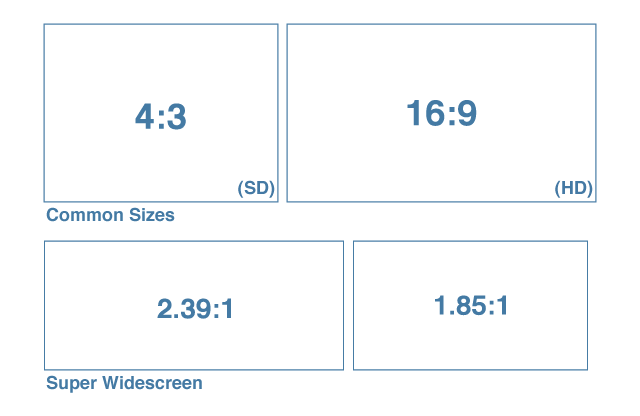
Bit rate (also known as data rate) is the amount of data used for each second of video. In the world of video, this is generally measured in kilobits per second (kbps), and can be constant and variable. For more information, check out our lesson on Video Compression.
Bokeh describes the character of the blur in an image, often used to specifically refer to points of light rendered as fuzzy circles. For more information, check out our lesson on Bokeh.
Boom microphones are long, highly directional microphones. They are normally attached to boom poles to capture dialogue in a scene. They also can be mounted directly on cameras to capture long distance sound. For more information, check out our lesson on Capturing Good Sound.
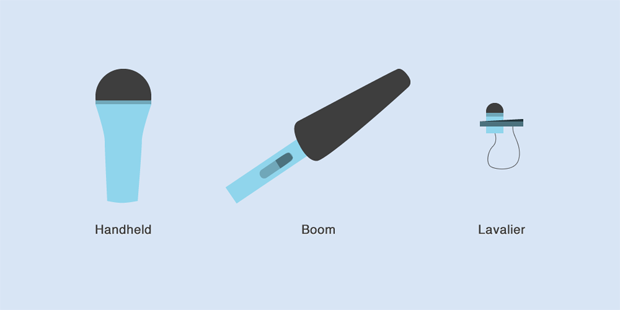
B-roll is supplemental footage that provides supporting details and greater flexibility when editing video. Common examples include the footage used to cut away from an interview or news report to help tell the story. For more information, check out our lesson on B-roll.
A Bounce refers to material used to literally bounce or reflect light onto your subject. Handy for evening out harsh shadows and dispersing light so it doesn’t appear to be coming from a single source. Especially useful when shooting outside in the harsh sun and indoors with artificial light. For more information, check out our lesson on Bounces.
Close up is a shot composition where the frame is filled almost entirely with the subject’s face. For more information, check out our lesson on Varying Your Shot Composition.
A Codec is the method a computer uses to determine the amount of change between frames of a video. For more information, check out our lesson on Video Compression.
Color Correction is when an editor digitally manipulates colors in post-production. For more information, check out our lesson An Introduction to Color Correction.
Color Temperature is a characteristic quality of the visible light in an image. It ranges from cool to warm, and is measured in the unit Kelvin. For more information, check out our lesson on Lights.
Compositing is the process of combining multiple images using post production software. For more information, check out our lesson on Animated Title Sequences.
Compression as it relates to video refers to reducing the amount of data in a video file. While it can take time to compress a video, it will upload faster, and also download quicker for anyone you choose to share the original file with. We strongly recommend you compress the videos you upload to Vimeo. You’ll be able to upload more videos that way! Check out our recommended compression settings here.
A Crane is a device used to capture moving shots with height, comprised of an arm with a camera attached to one end and a counterweight attached to the other. Often called a jib. For more information, check out our lesson on Jibs and Cranes.
Crop factor is a number, generally in the range of 1.3 to 2.0, that indicates the ratio of a sensor’s imaging area to that of a full frame sensor. Multiplying a lens’ focal length by a sensor’s crop factor gives the actual focal length for that sensor/lens combination. For more information, check out our lesson on Crop Factor.
A C-stand is essentially a heavy-duty tripod. C-stands are used by the grip department to execute various lighting and rigging tasks on a set. For more information, check out our lesson on C-stands.
Cut-in also known as insert shots, typically show objects or props that a character is manipulating. For more information, check out our lesson on Varying Your Shot Composition.
Depth of Field (DOF) refers to the part of your image that is in focus. A deep DOF will show nearly everything in the frame sharply in focus. If you have a shallow DOF, a narrow range within your video image will be in focus. A shallow depth of field allows for greater emphasis to be placed on your main subject. For more information, check out our lesson on Depth of Field.
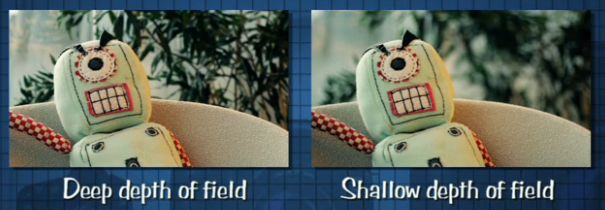
Diegetic sound refers to the sound that is present and/or captured during the recording of the video. For more information, check out our lesson on Capturing Good Sound.
Diffusion refers to material used on lights to reduce harsh shadows by softening light. For more information, check out our lesson on Diffusion.
Digital Zoom is a method of giving an appearance of zooming without an actual optical lens change. This is accomplished by cropping the image to a centered area while maintaining the same aspect ratio. For more information, check out our lesson on Optical vs. Digital Zoom.
DLP (Digital Light Projection) is a type of projector technology that uses a Digital Micromirror Device (DMD). A DMD consists of thousands of tiny computer-controlled mirrors, that together with a fast-spinning Color Filter (or Color Wheel) forms a moving image. For more information, check out our lesson on Projectors.
A Dolly is a piece of film equipment that runs on a track to create smooth camera movements. For more information, check out our lesson Do-It-Yourself Dolly and Shoulder Rig.
DSLR (Digital Single Lens Reflex) This is a type of camera that uses a mirror to reflect the light coming through the lens onto the viewfinder. When you press the shutter button on the camera, this mirror swings out of the way to allow light to reach the image sensor. For more information, check out our lesson on DSLR Mechanics.
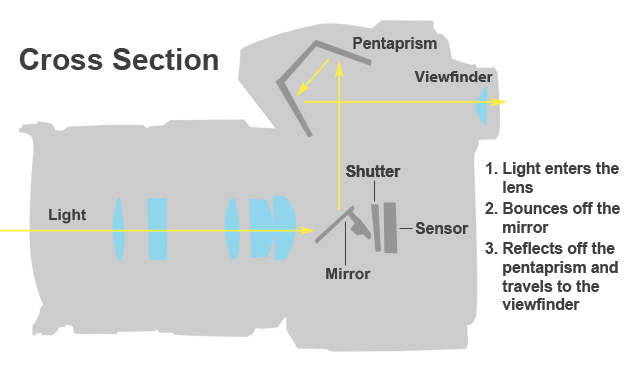
DVI is the digital connector successor to VGA. DVI plugs are often colored white. For more information, check out our lesson on TV/Computer Connections.
Dynamic range is the range of which a camera can successfully capture the lightest and darkest areas of an image without losing detail. For more information, check out our lesson on Dynamic Range.
Export refers to the process of assembling your edited video project into a single file that can then be played back on it’s own, shared, or uploaded.
Exposure is the amount of time light is allowed to hit the sensor. The longer your exposure, the more light will get in and the brighter your image will be.
Fade is the dissolve transition between a normal image and a black screen. When you dissolve from an image to black, it’s a fade out. When you dissolve from black to an image it’s called a fade in.
A Fauxtograph involves using a camera (that records video but isn’t specifically a video camera) and telling your subject you’re taking a photo, but secretly taking a video!
A 5×5 is a video composed of five 5-second clips and using original sound. Check out examples in the 5×5 Group.
Fluorescent lights emit light via mercury vapor and phosphor, they produce a soft, even light. The color temperature of fluorescent light depends on the lamp being used, and it can also be completely color-corrected in post. For more information, check out our lesson on Lights.
Focal length is the distance from the lens to the image focus point inside the camera. A high focal length makes distance objects appear magnified while a low focal length give a wide view of the scenery facing the lens. For more information, check out our lesson on Focal Length.
Foley is the art of reproducing and creating sounds for film. For more information, check out our lesson on Foley Artistry.
A Follow Focus is a control mechanism that allows you to easily make changes on the focus ring of your camera lens. For more information, check out our lesson on Do-It-Yourself Follow Focus.
F-stop is a term used to describe the size of the aperture opening. The lower the F-stop number, the bigger the aperture. If the aperture is low, more light is able reach the image sensor. F-stop settings are normally displayed with a forward slash. Common f-stops are: f/1.4, f/2, f/2.8, f/4, f/5.6, f/8, f/11, f/16, and f/22. A low f-stop number (large aperture) results in a shallow depth of field and a high f-stop (smaller aperture) gives a deep depth of field. For more information, check out our lesson on F-stops and Aperture.
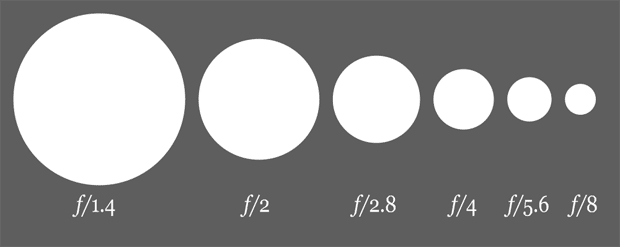
Frame Rate is the rate at which a shutter opens and closes, or a sensor captures video during one second. Typical frame rates are 24, 25, and 29.97, 30 and 50 and 60. For more information, check out our lesson on Frame Rate Vs. Shutter Speed.
A Fresnel is a type of lens placed in front of lamps (such as tungsten sources) in order to focus the light given off into a controllable beam. For more information, check out our lesson on Lights.
Gaff tape (or gaffers tape) is a type of non-damaging, super durable tape used on film sets, most often by the gaffer and grip department. For more information, check out our lesson on Gaff tape.
Gels are pieces of colored plastic used on lights. Gels allow light to pass through while changing the color tone of the light itself. For more information, check out our lesson on Gels.
HDMI (High-Definition Media Interface) is a digital connector prevalent across both consumer electronics and modern computers. HDMI carries both HD video and the audio signal to the TV. For more information, check out our lesson on TV/Computer connections .
HDR (high dynamic range) is the compositing of two images, one that properly exposes the highlights, and another that properly exposes the dark areas. When composited together, you get a properly exposed image. For more information, check out our lesson on Dynamic Range.
HMI (Hydrargyrum Medium-arc Iodide) lights emit light via pressurized mercury vapor and metal halides. Ideal for imitating daylight, they keep cooler and have a very high light output. HMI light has a color temperature of around 5600K. For more information, check out our lesson on Lights.
Hot shoe is a mounting point at the top of some cameras that allow you to attach a flash unit, microphones or other accessories.
Image Sensor is what your digital camera uses to convert an optical image into an electric signal that your camera interprets to produce the image you see. Common types of sensors are APS-C, micro four thirds, and full-frame. For more information, check out our lesson on Image Sensors.
Importing refers to the process of transferring videos from your camera onto your computer or into a piece of editing software.
I.S.O is a camera setting in the digital cameras that changes how sensitive the sensor is to light. The higher the ISO, the more sensitive the sensor is to light, allowing you to shoot video in low light conditions. Low ISOs are used to shoot video in daylight and bright light conditions and provide more detail in the image. For more information, check out our lesson on Mastering I.S.O..
A J-cut is a type of cut in which the sound of the next scene precedes the picture. The name comes from the shape these clips make in the timeline of an editing program. For more information, check out our lesson on J-cuts.
Jump Cut is an abrupt transition, typically in a sequential clip that makes the subject appear to jump from one spot to the other, without continuity. For more information, check out our lesson on Understanding Jump Cuts.
Latitude is the exposure flexibility of your captured image (how much you can alter it in post to attain the correct exposure). Latitude is dependent upon dynamic range. While dynamic range refers to a camera, latitude refers to the image it captures. For more information, check out our lesson on Dynamic Range.
Lavalier microphone is a small clip-on microphone that attaches to the subject’s clothing. Normally used on TV newscasts or sitcoms that require sound to be captured from the subject without it being obvious that there is a microphone attached.
LCD (Liquid Crystal Display) screens are similar to Plasma screens, and comprised of a thin layer of special liquid crystals sandwiched between sheets of polarized glass or plastic. Unlike a Plasma screen however, the liquid crystals don’t emit light. A backlight lies behind the liquid crystal sandwich to illuminate the image. For more information, check out our lesson on LCDs.
An L-cut is a type of cut in which the picture changes but the audio continues. The name comes from the shape these clips make in the timeline of an editing program. For more information, check out our lesson on L-cuts.
Lithium ion batteries are the preferred type of battery for use in high-end film equipment. Most cameras are designed to use lithium ion batteries, which are proprietary (meaning they are made for a specific camera model). For more information, check out our lesson on Batteries.
A Long Portrait is similar to a fauxtograph, except this time your subject is in on it. Takes portraiture photography and transfers it to video form, revealing a subject’s subtle expressions, mannerisms, and gestures.
Macro is a lens that uses a long barrel for close focusing. Typically, a macro lens is capable of creating a reproduction ratio greater than 1:1. The reproduction ratio is the size of your subject on your image sensor to the size of your actual subject. For more information, check out our lesson on Macro Lenses.
A Matte box is a box that sits on the front of the camera lens to block and absorb light, usually held up by a set of rails attached to the bottom of the camera. They’re used mainly to hold lens filters and to reduce lens flares by controlling the light coming into the camera. For more information, check out our lesson on Matte Boxes.
A Memory Bank is a video that documents certain time periods or events in someone’s life. It can be set to music, make use of natural sound, record vacations, or just capture moments in everyday life.
Memory Card is a data storage device used to store the digital information of your photos and videos on your camera. The two main types of memory cards are Secure Digital (SD) and Compact Flash (CF). For more information, check out our lesson on Memory Cards.
Me Right Now is a video of what you’re doing right now, kind of like a video status update. Check out examples in the Me Right Now Group.
A Monopod is similar to a tripod, but with only one ‘foot.’ It provides support but also mobility, and is handy in situations where bringing a tripod would be too cumbersome. For more information, check out our lesson on Monopods.
Neutral Density Filter is a piece of glass that fits over the front end of a lens to reduce the amount of light entering the camera. For more information, check out our lesson on Neutral Density Filters.
NiMH (nickel metal hydride) batteries are a type of battery used in some lower-end cameras. Although cheaper than Lithium ion batteries, they tend to lose charge when not in use and don’t provide as much overall power. For more information, check out our lesson on Batteries.
A One Minute Video is a video exactly one minute in length, containing no camera movements (panning, tilting, etc.) or editing, and making use of original sound. Check out examples in the One Minute Group.
Optical Zoom is the lens’ ability to change the focal length either closer to or further from a central subject. For more information, check out our lesson on Optical vs. Digital Zoom.
Over The Shoulder shots are framed with an emphasis on a particular character’s perspective. This shot is used in dialogue scenes to show conversations between two people. For more information, check out our lesson on Varying Your Shot Composition.
Pans are fixed, lateral movements made with the camera.
Picture Profile refers to the four dimensions of in-camera picture settings: sharpness, contrast, saturation, and color tone. You can create a custom picture style, or use an already established picture style, like one of the six Canon presets, or download one from a third party, such as Cinestyle from Technicolor, or Cine from Marvel. For more information, check out our lesson on In-Camera Settings.
Pixel Aspect Ratio: your video image is made up of thousands of little squares called pixels. The width of each pixel relative to its height is know as the pixel aspect ratio. For uploading to Vimeo set your pixel aspect ratio (PAR) to 1:1 or 1.00.
Plasma screens are comprised of hundreds of thousands of tiny gas-filled cells sandwiched between two sheets of glass. When an electric charge is applied to one of these gas-filled cells, it emits light, making up one of the thousands of pixels on-screen. For more information, check out our lesson on Plasma Screens.
Polarizing Filter is a piece of glass that fits over the front end of a lens to change the way that your camera sees and treats light, while ultimately cutting down on glare. For more information, check out our lesson on Polarizing Lens.
A POV (point of view) shot is a shooting technique that shows the perspective of a scene literally from a character or object’s position in the setting. For more information, check out our lesson on POV.
A Practical refers to any light source that is part of the scene itself and does not need to be hidden from the camera. For more information, check out our lesson on Lights.
A Press kit provides background information on your film for members of the press for promotional purposes. It can include an in-depth synopsis, cast and crew bios, interesting anecdotes or a Q&A with the director, reviews of the film, and production stills. For more information, check out our lesson on Film Festivals.
A Prime lens is a lens with a fixed focal length. Although less versatile than a zoom, prime lenses often provide superior optical quality and wider apertures (often down to 1.2 or 1.4), and are lighter weight and less bulky. For more information, check out our lesson An Introduction to Lenses.
Room Tone is the presence, or sound in a room. It is recorded and later intercut with dialogue to smooth out any rough or jarring editing points. For more information, check out our lesson on Room Tone, Presence and Ambience.
Resolution is a measure of the number of pixels a video contains both horizontally and vertically. Some common resolutions are 640×480 (SD) 1280×720 (HD), 1920×1080 (HD). Sometimes these are referred to just by their vertical dimension such as, 480p, 720p or 1080p. For more information, check out our lesson on The Basics of Image Resolution.
![]()
The Rule of Thirds is a method of composing your shots in an aesthetically pleasing way. For more information, check out our lesson on Framing and Composition.
A Screener is a version of a film for sending to film festivals and press. Often requested as a DVD, but sometimes accepted online, screeners should be formatted correctly and marked with the appropriate information requested by the festival. For more information, check out our lesson on Film Festivals.
Screenplay is a formatted written work that includes stage direction, action, character names and dialogue. For more information, check out our lesson on Screenplay Formatting.
Shot List is a full log of all the shots you want to include in your film; essentially it is a checklist filled with minute details that will give your film a sense of direction and efficiency. For more information, check out our lesson on Making a Shot List.
Shoulder Rig is a piece of equipment used to help stabilize a handheld camera. For more information, check out our lesson Do-It-Yourself Dolly and Shoulder Rig.
Shutter speed is the amount of time that each individual frame is exposed for when shooting video on a DSLR. For example, if you set your camera’s shutter speed to 60, each frame is being exposed for 1/60th of a second. For more information, check out our lesson on Shutter Speed.
A Slate is a rectangular board and clapstick that produces a sharp ‘clap’ sound. Used for capturing and organizing sound during production, making the job of the editor easier when syncing picture and sound in post. For more information, check out our lesson on Slating.
A Slider is a device that uses a track to allow smooth camera movements laterally, front to back, or even diagonally.
Slow Motion is the action of slowing down pre-recorded footage to a different speed. For more information, check out our lesson Slow Motion on a Budget.
A Snorricam is a camera rig attached to the body of an actor to create the effect of a background that moves dynamically around a subject that remains stationary. Also known as a chestcam or bodymount camera. For more information, check out our lesson on Building a Snorricam.
Split screen incorporates more than one simultaneous image in the screen. Usually it’s divided in two, but there can be many more.
A Steadicam is a flying camera stabilizer (often comprised of an arm, vest, and sled) that enables cinematographers to get smooth moving shots. For more information, check out our lesson on Flying Camera Stabilizers.
Stop motion is an animation technique used to make objects appear as if they were moving freely.
Storyboards are drawings that show each scene of your film, creating a blueprint for your movie. Storyboards provide a clear and concise visual plan for what you need to shoot or animate. For more information, check out our lesson on Storyboarding.
A Swishblog is a unique way of vid-blogging (invented by Vimean Justin Johnson) that makes use of quick pans or tilts at the beginning and end of every shot to transition between clips and give your video a fun, dream-like feel.
Sync or *synchronization* refers to the sound lining up properly with the image.
Telephoto is a lens that uses a telephoto group to enable a longer focal length than the physical body of the lens would normally permit. This allows the lens to magnify images, while maintaining its small size.
Three-point lighting is a common type of lighting setup that lights a subject from three different sources in order to control shadows and balance contrast. The three lights are typically called back, key, fill lights. For more information, check out our lesson on Three-Point Lighting.
Tilts are fixed up and down, or vertical, movements made with the camera.
Timelapse is a technique where each frame in a video is captured at a much slower rate than normal. When played back at normal speed, time appears to go by faster. This can also be achieved by fast forwarding or increasing the speed of your video in an editing program. For more information, check out our lesson on Timelapse.
A Tracking (or dolly) shot physically advances or changes the position of the camera relative to the subject, changing the spatial relations between a subject and its surroundings. These shots are often captured using a dolly or slider. For more information, check out our lesson on Zoom vs. Moving Camera Shots.
Tungsten lights emit light using a filament of tungsten wire, and are larger versions of the everyday lighting found in your home. Tungsten light has a color temperature of around 3200K. For more information, check out our lesson on Lights.
VGA is a type of analog connector found on older flat-panel TVs and computers. VGA connectors and plugs are commonly colored blue. For more information, check out our lesson on TV/Computer Connections.
Video provides the magical elixir that keeps Vimeo’s heart beating, its engine running, and its soul soaring.
Video Blogs are simply what their name states, blogging through the format of video. For more information, check out our lesson Art of the Vidblog.
Viewfinder is the part of the camera you look through to see the image from your lens’ field of view.
Wide angle is a lens that uses a grouping of glass to enable a shorter focal length than the physical body of the lens would normally permit. In doing so, the wide angle lens can capture more of a subject from an equal distance when compared to a normal lens of the same size.
White balance is the process of capturing the correct colors for the type of available light. Think of it as making sure the color white is always white, and doesn’t have blue or red tints. Many cameras come with a white balance menu, as well as an auto white balance feature. For more information, check out our lesson on White Balance.
A Zoom lens is a lens with a ring that allows for zooming in and out between a range of focal lengths within the single lens. For more information, check out our lesson An Introduction to Lenses.
A Zoom shot makes the subject larger or smaller within the frame simply by shifting the lens elements inside to change focal lengths. This magnifies the view of the subject while the camera itself remains stationary. For more information, check out our lesson on Zoom vs. Moving Camera Shots.


